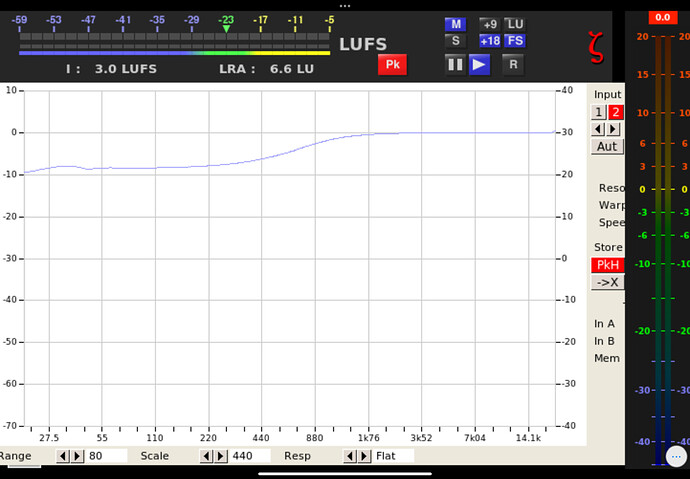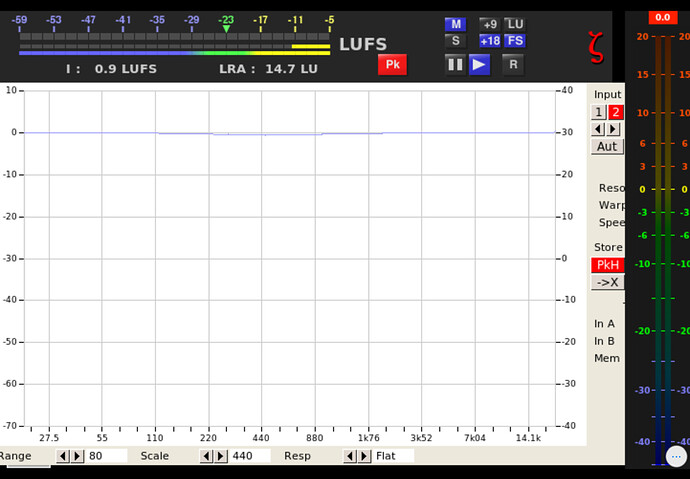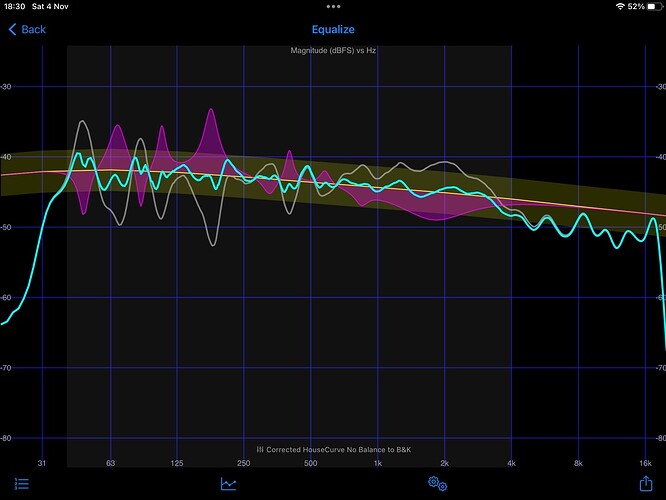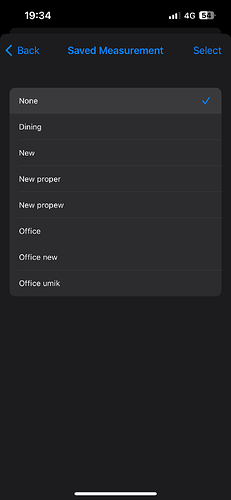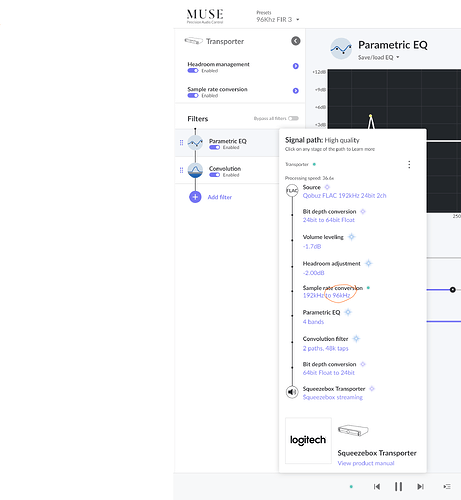Just rechecked with my metering bridge and found I shared the wrong file, try this one instead - sorry for the confusion…
no luck ![]() Doesn’t even clip at 0dB headroom!
Doesn’t even clip at 0dB headroom!
As you posted your finding, I remembered that back in the day I had found that my REW measurement signal exports repeatably exhibit the same strange spectral distribution:
Linear sweep spectrum is …
Logarithmic sweep spectrum is …
Fun stuff! ![]()
Just a quick post to say thank you to @Greg_Wilding for a brilliant piece of software! ![]() I already had a Umik mic so once I had loaded the calibration file into HouseCurve and selected the external mic I think the whole measurement process took just a couple of minutes (as opposed to half an hour of fiddling in REW last time I used it) - once I had realised I had to click the ‘+’ button each time for a new measurement that is - as Greg says in the manual, this is not RTA!!!
I already had a Umik mic so once I had loaded the calibration file into HouseCurve and selected the external mic I think the whole measurement process took just a couple of minutes (as opposed to half an hour of fiddling in REW last time I used it) - once I had realised I had to click the ‘+’ button each time for a new measurement that is - as Greg says in the manual, this is not RTA!!!
I found the best way was to export the sweep file to ‘files’ on the iPad into a folder called Test Files, then on the Mac copy this folder into Roon storage as an album in the ‘Compilations’ folder - this makes it easy to find later. Then I simply played the sweep on loop, just pressing ‘+’ in HouseCurve as and when I was ready to do another measurement out of the five or so around my head at the seating position. Really easy.
The reading was almost identical to REW, so that was nice to confirm, equalisation was instant and I went with the basic B&K house curve. After importing all .wav files zipped into Roon I set up a new convolution filter and compared with no filter and the previous filters I had set up manually from REW PEQ numbers. The HouseCurve adjustments were excellent straight out of the box, better actually, very natural.
I have since modified the house curve, used Harman and my old curve (which I think I grabbed from the REW tutorial thread on here) it has an uplifted bass with a dip before it and rapidly descending treble end… none of these were a patch on the basic B&K I have to say!
So job done, till the next equipment change or glass of wine… its so simple to use HouseCurve it almost encourages experimentation! ![]()
Nice feedback, I too wish REW was this easy - so much lost time…
Based on your curve, it does look like you could use a subwoofer to get sound <40Hz and I would be cautious with attenuating/EQing into the mid-range above 500/600Hz…. I would play around with HouseCurve EQ settings and see what you think about an A/B test between your current setting and simple 40-500 bass/ low mid EQ. I’ve found some issues when bringing down midrange like you showed in your graph.
With that said, do what sounds best, every room and system is unique. Enjoy!
Thanks Tim! Hehe, yep, easy experimentation was a design goal. Glad you like the app ![]()
Yes it is all about trial and error isn’t it! ![]() The biggest problem in my room, and I think it is the room (or my full range single driver floor standers?) as various changes of equipment haven’t altered it - is that hump at 2Khz. Until I actually measured the system I had tried all sorts of cables to help with the harsh grating treble, it was a relief to see REW eventually confirm what I had been hearing.
The biggest problem in my room, and I think it is the room (or my full range single driver floor standers?) as various changes of equipment haven’t altered it - is that hump at 2Khz. Until I actually measured the system I had tried all sorts of cables to help with the harsh grating treble, it was a relief to see REW eventually confirm what I had been hearing.
I have another house curve that raises the 800-1100Khz range to bring voices up a bit, a gentle slope including the 500KHz band, but in my room it barely makes any difference - it’s that treble that plagued me! ![]()
First time poster with what I hope is an easy question. I bought HouseCurve yesterday, made measurements and got an impulse file to Roon. I like the app and rate results were great (fairly well treated room so nothing too drastic). However, now I want to start from scratch again with different speaker placement and cannot figure out how to set everything back to square 1 so I can, for example, do measurements with speakers 30” from front wall and 90” apart versus 50” and 80” like the first set. I put all of the first measurements in trash bin but there is still the gray outline of the first average (I did 5 measurements), and I would like the screen empty so I can start a whole new process. As an aside, I am using this with Kef LS 60 speakers. My other system is Salk speakers with an Anthem STR Integrated using ARC. I loved ARC so I much with that system I searched for and found HouseCurve, which is kind of an ARC lite.
Choose save measurements and select none. Choose the curve button from the bottom buttons to access it.
I knew there would be an easy solution that I had simply missed! Thank you.
Hello, I released HouseCurve-5.1 today. This brings some equalization improvements:
- Ability to create FIR filters for high fidelity room correction
- Produce “cut only” filters for improved gain management
- Set maximum Q for PEQ based room correction
- Improvements for manual target curve fitting
I think FIR filter support will be of interest to Roon users. Instead of converting a set of PEQ filters to an impulse, HouseCurve can now directly create a mixed phase FIR filter. The result should be more even bass notes and improved sound stage / imaging (especially if you correct L/R separately).
I’ve learned that creating a decent FIR filter is a bit of an art, so I’m very interested in hearing your thoughts and suggestions. Enjoy!
I have been threatening to try this for a while for use with Roon where I do not have DIRAC. Hopefully this will kick me into doing at least one Room and then more ![]()
I’ve been loving this app everywhere.
Would love a couple of things:
- Option to export convolutions to a zip file. Perfect for Roon
- Volume check with confirmation before playing the full test tone. For some reason on my Naim Atom, volume was much much higher than it should have been.
Thank you for this great program!
I’m 8 hrs into brand new Wharfedale Lintons. Perfect timing to try the new version, with HQPlayer too.
I’m still on B’s as I work through my favourite albums alphabetically.
We use Roon and would like to correct L/R separately as you suggest. Are the steps below how we should do this:
• Place mic in listening position.
• Plotmode to History
• Turn off delay
• Measure L with Sub/R with Sub channels separately.
• Export FIR for both L+Sub/R +Sub into zip file (Our transport has max sample rate of 96kHz so presumably this is the figure to export).
• In Roon Convolution Filter browse to saved Zip.
Presume cant average results using separate L/R measurements due to time delay?
Great App has removed the bass boom that was there even though upgraded speakers!
You’re a star! ![]() I’ve noticed you are on the Wiim group as well, and I’ve seconded a suggestion they get implementing a way to import your files, I think they are only 4 band at present but promise 10 band shortly… and like your good self they seem to deliver what they promise and sometimes a bit more!!
I’ve noticed you are on the Wiim group as well, and I’ve seconded a suggestion they get implementing a way to import your files, I think they are only 4 band at present but promise 10 band shortly… and like your good self they seem to deliver what they promise and sometimes a bit more!! ![]()
Now… if Wiim was able to integrate HouseCurve directly, in a seamless way, they would have a unique killer little streamer at a great price! (I know daft idea, I mean you might have to give up the day job!!! ![]() )
)
I probably shouldn’t say this here, but when the Wiim Pro can support Qobuz Connect (again in the process) and it offers PEQ sufficient bands AND I can tweak the l/r balance (again on the cards) it’s bye bye Roon… I’m enjoying the Qobuz Mac App so much lately and it sounds great! ![]()
![]()
Hi Tom,
For muli-channel correction, you basically repeat the measurement process for each channel and produce a correction. You can use the sweep channel setting to control the L/R speaker output, but any other means of muting channels will work.
I recommend averaging 3-5 measurements in the listening area for each channel - this avoids correcting features that only exist in one location. It’s important to measure from the same locations in the room for each channel. You don’t have to be perfect, but reasonably close. Also, the locations should be symmetric around a center measurement so that L/R sides are measured equally.
I would enable the “remove delay” feature. This aligns impulses before averaging, giving a better “average of experience”.
When generating the corrections, use manual curve fitting. This ensures the target curve stays at the same level for each correction.
Other than that, I think you’ve got the right idea. Hope this helps!
Greg
Thanks Greg!
Going to give it a go
Hi Tom,
Why measure L and R separately? Is there any difference compared to measuring both together?
Is that what I should be doing?
Edit. I have just read the section regarding L and R separate with a sub (which is what I need). Back to the drawing board
